Abstract
We have evaluated the hypolipidemic effects of mevinolin, a competitive inhibitor of 3-hydroxy-3-methylglutaryl coenzyme A reductase, the rate-limiting enzyme in cholesterol biosynthesis in 13 patients with heterozygous familial hypercholesterolemia (FH). Patients were maintained on a low-cholesterol diet and received sequentially increasing doses of 5, 10, 20, and 40 mg of mevinolin twice daily for a period of 1 mo on each dose. Plasma concentrations of low density lipoprotein cholesterol decreased by 19.8% on the 5 mg twice daily dose (P less than 0.05 vs. base line), 28.4% on 10 mg of mevinolin twice daily (P less than 0.05 vs. 5 mg twice daily), 35% on 20 mg of mevinolin twice daily (P less than 0.05 vs. 10 mg twice daily), and 37.7% on 40 mg of mevinolin twice daily (not statistically different from 20 mg twice daily). Concentrations of high density lipoprotein cholesterol remained stable on all doses of mevinolin whereas plasma triglyceride levels fell significantly on the 20 mg (-30.7%) and 40 mg (-34.3%) twice daily doses of mevinolin. Mevinolin was well tolerated and all patients completed the study period. Side effects during the period of study were limited to transient insomnia and headaches in two patients, transient increases in alkaline phosphatase in three patients, and a modest but sustained increase in alkaline phosphatase in a fourth patient. These results indicate that mevinolin is an effective hypolipidemic agent in patients with heterozygous FH but that the optimal doses in these patients are greater than those previously reported in normal volunteers. If long-term safety can be satisfactorily established, mevinolin offers considerable promise in the therapy of heterozygous FH.
Full text
PDF
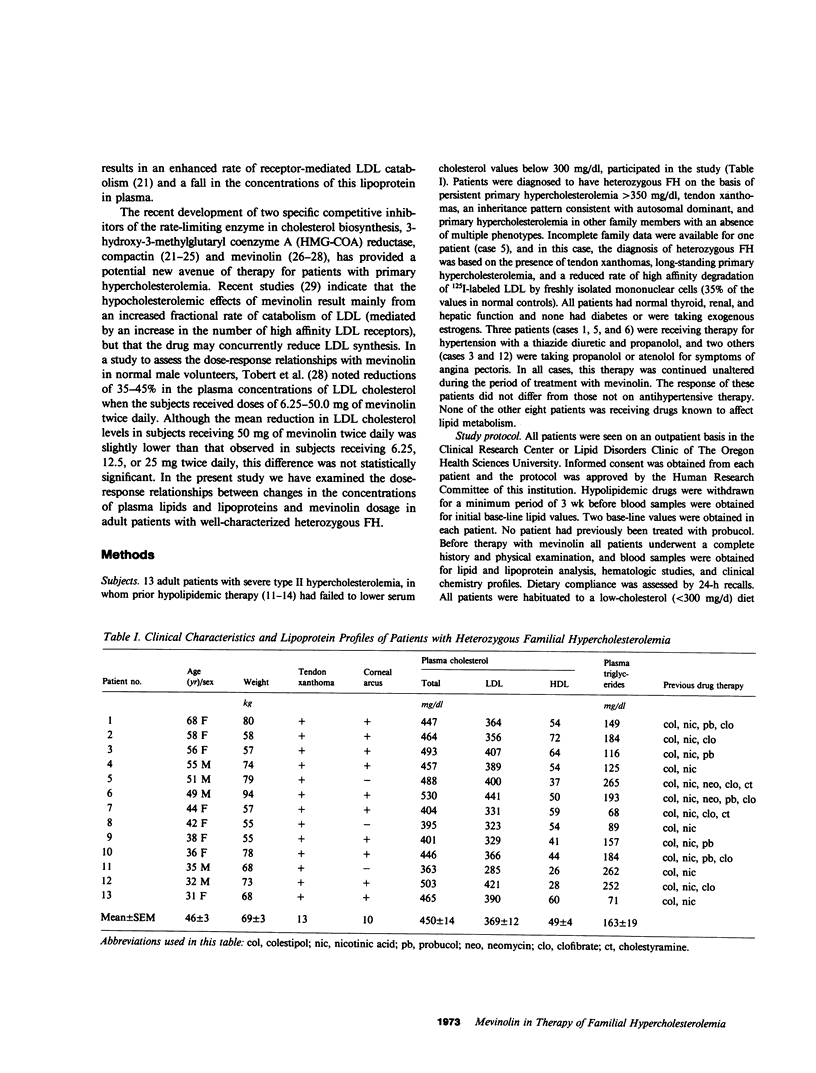
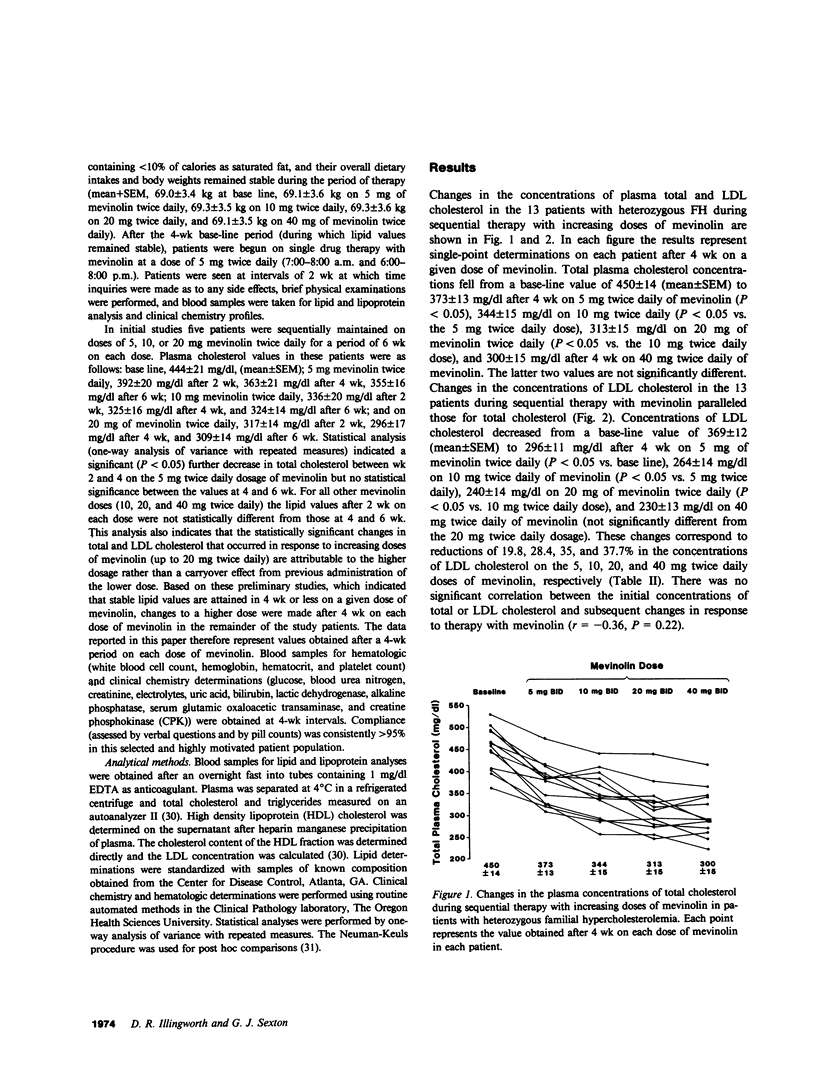
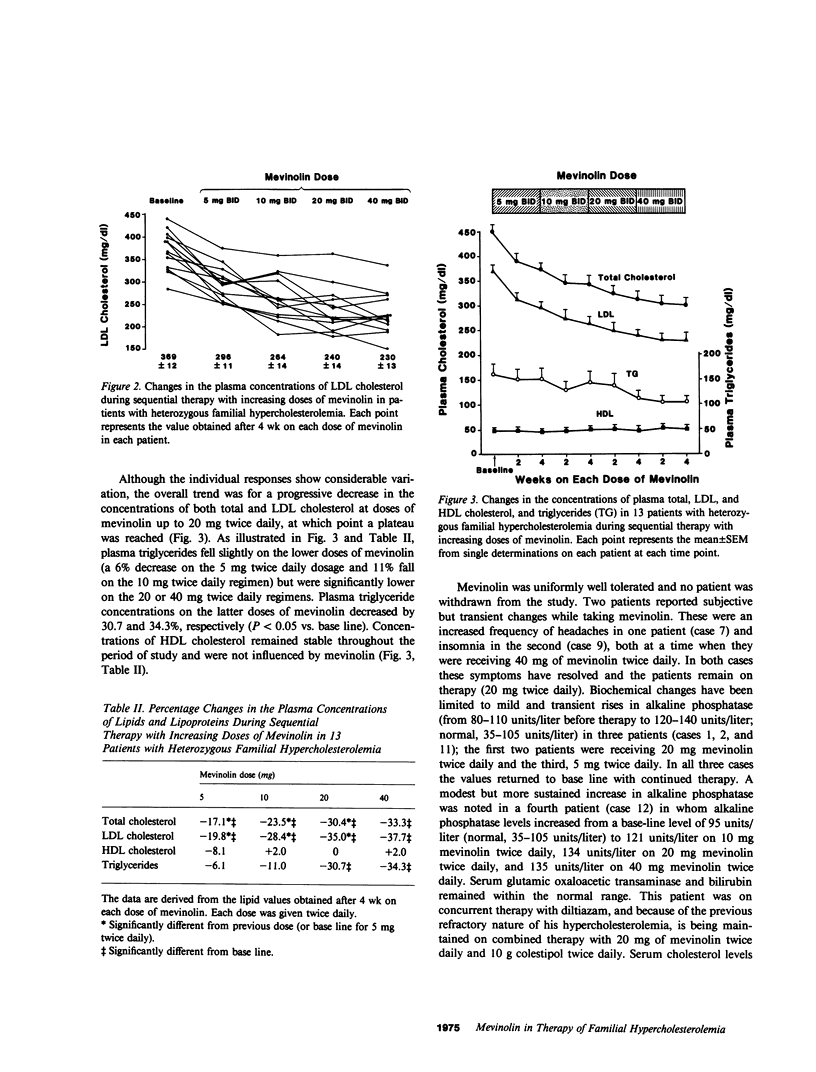
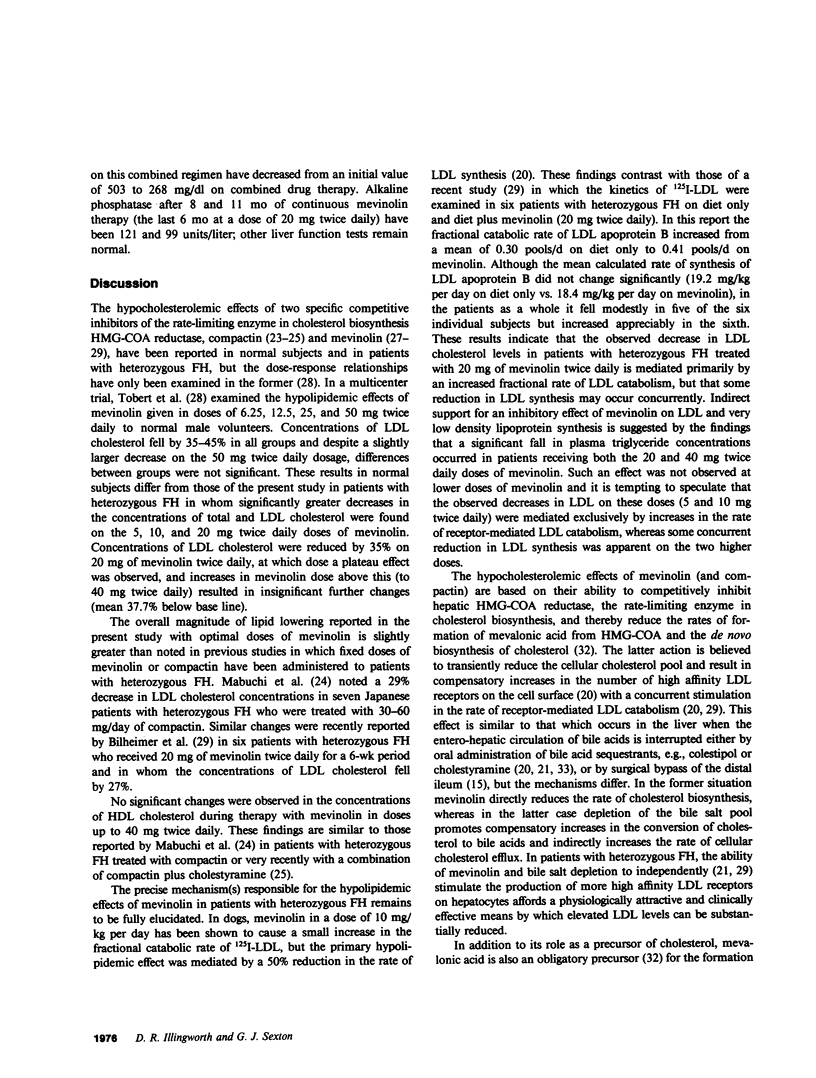
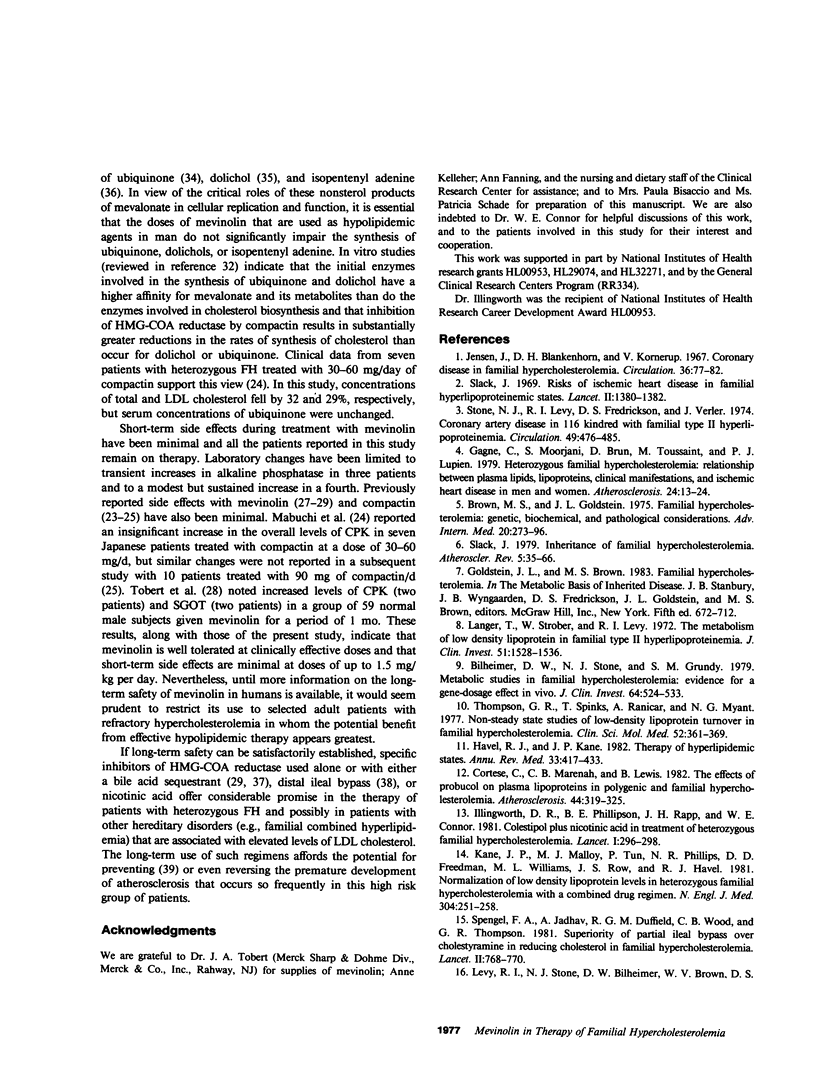

Selected References
These references are in PubMed. This may not be the complete list of references from this article.
- Alberts A. W., Chen J., Kuron G., Hunt V., Huff J., Hoffman C., Rothrock J., Lopez M., Joshua H., Harris E. Mevinolin: a highly potent competitive inhibitor of hydroxymethylglutaryl-coenzyme A reductase and a cholesterol-lowering agent. Proc Natl Acad Sci U S A. 1980 Jul;77(7):3957–3961. doi: 10.1073/pnas.77.7.3957. [DOI] [PMC free article] [PubMed] [Google Scholar]
- Bilheimer D. W., Grundy S. M., Brown M. S., Goldstein J. L. Mevinolin and colestipol stimulate receptor-mediated clearance of low density lipoprotein from plasma in familial hypercholesterolemia heterozygotes. Proc Natl Acad Sci U S A. 1983 Jul;80(13):4124–4128. doi: 10.1073/pnas.80.13.4124. [DOI] [PMC free article] [PubMed] [Google Scholar]
- Bilheimer D. W., Stone N. J., Grundy S. M. Metabolic studies in familial hypercholesterolemia. Evidence for a gene-dosage effect in vivo. J Clin Invest. 1979 Aug;64(2):524–533. doi: 10.1172/JCI109490. [DOI] [PMC free article] [PubMed] [Google Scholar]
- Brown M. S., Goldstein J. L. Familial hypercholesterolemia: genetic, biochemical and pathophysiologic considerations. Adv Intern Med. 1975;20:273–296. [PubMed] [Google Scholar]
- Brown M. S., Goldstein J. L. Multivalent feedback regulation of HMG CoA reductase, a control mechanism coordinating isoprenoid synthesis and cell growth. J Lipid Res. 1980 Jul;21(5):505–517. [PubMed] [Google Scholar]
- Chao Y. S., Yamin T. T., Alberts A. W. Catabolism of low density lipoproteins by perfused rabbit livers: cholestyramine promotes receptor-dependent hepatic catabolism of low density lipoproteins. Proc Natl Acad Sci U S A. 1982 Jul;79(13):3983–3986. doi: 10.1073/pnas.79.13.3983. [DOI] [PMC free article] [PubMed] [Google Scholar]
- Cortese C., Marenah C. B., Miller N. E., Lewis B. The effects of probucol on plasma lipoproteins in polygenic and familial hypercholesterolaemia. Atherosclerosis. 1982 Sep;44(3):319–325. doi: 10.1016/0021-9150(82)90006-5. [DOI] [PubMed] [Google Scholar]
- Endo A., Kuroda M., Tanzawa K. Competitive inhibition of 3-hydroxy-3-methylglutaryl coenzyme A reductase by ML-236A and ML-236B fungal metabolites, having hypocholesterolemic activity. FEBS Lett. 1976 Dec 31;72(2):323–326. doi: 10.1016/0014-5793(76)80996-9. [DOI] [PubMed] [Google Scholar]
- Gagné C., Moorjani S., Brun D., Toussaint M., Lupien P. J. Heterozygous familial hypercholesterolemia. Relationship between plasma lipids, lipoproteins, clinical manifestations and ischaemic heart disease in men and women. Atherosclerosis. 1979 Sep;34(1):13–24. doi: 10.1016/0021-9150(79)90101-1. [DOI] [PubMed] [Google Scholar]
- Havel R. J., Kane J. P. Therapy of hyperlipidemic states. Annu Rev Med. 1982;33:417–433. doi: 10.1146/annurev.me.33.020182.002221. [DOI] [PubMed] [Google Scholar]
- Huneeus V. Q., Wiley M. H., Siperstein M. D. Isopentenyladenine as a mediator of mevalonate-regulated DNA replication. Proc Natl Acad Sci U S A. 1980 Oct;77(10):5842–5846. doi: 10.1073/pnas.77.10.5842. [DOI] [PMC free article] [PubMed] [Google Scholar]
- Illingworth D. R., Connor W. E. Hypercholesterolemia persisting after distal ileal bypass: response to mevinolin. Ann Intern Med. 1984 Jun;100(6):850–851. doi: 10.7326/0003-4819-100-6-850. [DOI] [PubMed] [Google Scholar]
- Illingworth D. R., Phillipson B. E., Rapp J. H., Connor W. E. Colestipol plus nicotinic acid in treatment of heterozygous familial hypercholesterolaemia. Lancet. 1981 Feb 7;1(8215):296–298. doi: 10.1016/s0140-6736(81)91910-3. [DOI] [PubMed] [Google Scholar]
- Jensen J., Blankenhorn D. H., Kornerup V. Coronary disease in familial hypercholesterolemia. Circulation. 1967 Jul;36(1):77–82. doi: 10.1161/01.cir.36.1.77. [DOI] [PubMed] [Google Scholar]
- Kane J. P., Malloy M. J., Tun P., Phillips N. R., Freedman D. D., Williams M. L., Rowe J. S., Havel R. J. Normalization of low-density-lipoprotein levels in heterozygous familial hypercholesterolemia with a combined drug regimen. N Engl J Med. 1981 Jan 29;304(5):251–258. doi: 10.1056/NEJM198101293040502. [DOI] [PubMed] [Google Scholar]
- Kovanen P. T., Bilheimer D. W., Goldstein J. L., Jaramillo J. J., Brown M. S. Regulatory role for hepatic low density lipoprotein receptors in vivo in the dog. Proc Natl Acad Sci U S A. 1981 Feb;78(2):1194–1198. doi: 10.1073/pnas.78.2.1194. [DOI] [PMC free article] [PubMed] [Google Scholar]
- Langer T., Strober W., Levy R. I. The metabolism of low density lipoprotein in familial type II hyperlipoproteinemia. J Clin Invest. 1972 Jun;51(6):1528–1536. doi: 10.1172/JCI106949. [DOI] [PMC free article] [PubMed] [Google Scholar]
- Lees A. M., McCluskey M. A., Lees R. S. Results of colestipol therapy in Type II hyperlipoproteinemia. Atherosclerosis. 1976 Jul-Aug;24(1-2):129–140. doi: 10.1016/0021-9150(76)90070-8. [DOI] [PubMed] [Google Scholar]
- Mabuchi H., Haba T., Tatami R., Miyamoto S., Sakai Y., Wakasugi T., Watanabe A., Koizumi J., Takeda R. Effect of an inhibitor of 3-hydroxy-3-methyglutaryl coenzyme A reductase on serum lipoproteins and ubiquinone-10-levels in patients with familial hypercholesterolemia. N Engl J Med. 1981 Aug 27;305(9):478–482. doi: 10.1056/NEJM198108273050902. [DOI] [PubMed] [Google Scholar]
- Mabuchi H., Sakai T., Sakai Y., Yoshimura A., Watanabe A., Wakasugi T., Koizumi J., Takeda R. Reduction of serum cholesterol in heterozygous patients with familial hypercholesterolemia. Additive effects of compactin and cholestyramine. N Engl J Med. 1983 Mar 17;308(11):609–613. doi: 10.1056/NEJM198303173081101. [DOI] [PubMed] [Google Scholar]
- Miettinen T. A., Lempinen M. Cholestyramine and ileal by-pass in the treatment of familial hypercholesterolaemia. Eur J Clin Invest. 1977 Dec;7(6):509–514. doi: 10.1111/j.1365-2362.1977.tb01644.x. [DOI] [PubMed] [Google Scholar]
- Mills J. T., Adamany A. M. The role of phosphorylated dolichols in membrane glycoprotein biosynthesis: relation to cholesterol biosynthesis. Int Rev Cytol. 1981;73:103–147. doi: 10.1016/s0074-7696(08)61287-5. [DOI] [PubMed] [Google Scholar]
- Shepherd J., Packard C. J., Bicker S., Lawrie T. D., Morgan H. G. Cholestyramine promotes receptor-mediated low-density-lipoprotein catabolism. N Engl J Med. 1980 May 29;302(22):1219–1222. doi: 10.1056/NEJM198005293022202. [DOI] [PubMed] [Google Scholar]
- Slack J. Risks of ischaemic heart-disease in familial hyperlipoproteinaemic states. Lancet. 1969 Dec 27;2(7635):1380–1382. doi: 10.1016/s0140-6736(69)90930-1. [DOI] [PubMed] [Google Scholar]
- Spengel F. A., Jadhav A., Duffield R. G., Wood C. B., Thompson G. R. Superiority of partial ileal bypass over cholestyramine reducing cholesterol in familial hypercholesterolaemia. Lancet. 1981 Oct 10;2(8250):768–770. doi: 10.1016/s0140-6736(81)90183-5. [DOI] [PubMed] [Google Scholar]
- Stone N. J., Levy R. I., Fredrickson D. S., Verter J. Coronary artery disease in 116 kindred with familial type II hyperlipoproteinemia. Circulation. 1974 Mar;49(3):476–488. doi: 10.1161/01.cir.49.3.476. [DOI] [PubMed] [Google Scholar]
- Thompson G. R., Spinks T., Ranicar A., Myant N. B. Non-stedy-state studies of low-density-liproprotein turnover in familial hypercholesterolaemia. Clin Sci Mol Med. 1977 Apr;52(4):361–369. doi: 10.1042/cs0520361. [DOI] [PubMed] [Google Scholar]
- Tobert J. A., Bell G. D., Birtwell J., James I., Kukovetz W. R., Pryor J. S., Buntinx A., Holmes I. B., Chao Y. S., Bolognese J. A. Cholesterol-lowering effect of mevinolin, an inhibitor of 3-hydroxy-3-methylglutaryl-coenzyme a reductase, in healthy volunteers. J Clin Invest. 1982 Apr;69(4):913–919. doi: 10.1172/JCI110530. [DOI] [PMC free article] [PubMed] [Google Scholar]
- Tobert J. A., Hitzenberger G., Kukovetz W. R., Holmes I. B., Jones K. H. Rapid and substantial lowering of human serum cholesterol by mevinolin (MK-803), an inhibitor of hydroxymethylglutaryl-coenzyme A reductase. Atherosclerosis. 1982 Jan;41(1):61–65. doi: 10.1016/0021-9150(82)90070-3. [DOI] [PubMed] [Google Scholar]
- Trumpower B. L. New concepts on the role of ubiquinone in the mitochondrial respiratory chain. J Bioenerg Biomembr. 1981 Apr;13(1-2):1–24. doi: 10.1007/BF00744743. [DOI] [PubMed] [Google Scholar]
- Yamamoto A., Sudo H., Endo A. Therapeutic effects of ML-236B in primary hypercholesterolemia. Atherosclerosis. 1980 Mar;35(3):259–266. doi: 10.1016/0021-9150(80)90124-0. [DOI] [PubMed] [Google Scholar]


